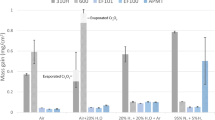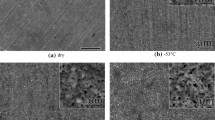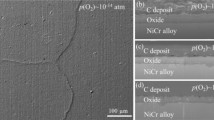Abstract
The formation of thin oxide films (<1000 Å) on polished iron-carbon alloys in the temperature range of 200–350°C and in 100 Torr of dry oxygen was investigated. A combination of vacuum microbalance and transmission electron microscopy techniques were employed to characterize the oxidation process kinetically and morphologically, respectively. The initial oxide formation on the iron-carbon alloys obeyed a two-stage logarithmic kinetic mechanism with activation energies of 0.26 eV and 0.32 eV for the first and second stage, respectively. These kinetics and activation energies are in agreement with the two-stage logarithmic kinetic theory developed by Uhlig, assuming electron transfer as the rate-controlling mechanism. Logarithmic kinetics were followed by parabolic kinetics with an activation energy of 1.08 eV, indicating cationic grain boundary diffusion as the rate controlling mechanism. The oxide formed over the iron-carbon alloys at 300°C was primarily due to the oxidation of the ferrite phase, but a thin protective oxide film (~ 150 Å) was formed on the carbide phase. At later stages, a lateral growth of the oxide crystallites formed over the ferrite phase resulted in a gradual coverage of the carbide phase. This lateral growth was the major effect of the second phase on the oxidation of two-phase iron-carbon alloys. A systematic study of the effect of the phase boundary length on the oxidation of iron-carbon alloys was quantitatively evaluated.
Similar content being viewed by others
References
V. J. Bohnenkamp and H. J. Engell,Arch. Eisenhuettenw. 33, 359 (1962).
W. E. Boggs and R. H. Kachik,J. Electrochem. Soc. 116, 424 (1969).
D. Davies, U. R. Evans, and J. Agar,Proc. Roy. Soc. A225, 443 (1954).
E. J. Caule and M. Cohen,J. Electrochem. Soc. 108, 834 (1961).
W. E. Boggs, R. H. Kachik, and G. E. Pellissier,J. Electrochem. Soc. 108, 6 (1961).
R. T. DeHoff, Lecture Note, University of Florida (1966).
S. A. Saltykov,Stereometric Metallography, 2nd ed. (Metallurgizdat, Moscow, 1958), p. 446. Cited in R. T. DeHoff and F. N. Rhines,Quantitative Metallography (McGraw-Hill, New York, 1968), p. 101.
M. Gensamer, E. B. Pearsall, W. S. Pellini, and J. R. Low, Jr.,Trans. ASM 30, 983 (1942).
W. H. Vernon, E. A. Calnan, C. J. Clews, and T. J. Nurse,Proc. Roy. Soc. A216, 375 (1953).
O. Kubaschewski and B. E. Hopkins,Oxidation of Metals and Alloys (Butterworth, London, 1962), p. 79.
H. H. Uhlig,Acta Met. 4, 541 (1956).
A. H. Michaelson,J. Appl. Phys. 21, 536 (1950).
H. H. Uhlig, J. Pickett, and J. MacNairn,Acta Met. 7, 111 (1959).
V. A. Nwoko and H. H. Uhlig,J. Electrochem. Soc. 112, 1181 (1965).
C. Wagner,Atom Movements (American Society for Metals, Cleveland, 1951), p. 153.
L. Himmel, R. F. Mehl, and C. E. Birchenall,J. Metals 5, 827 (1953).
D. McLean,Grain Boundaries in Metals (Oxford University Press, New York, 1957).
J. M. Perrow, W. W. Smeltzer, and J. D. Embury,Acta Met. 16, 1209 (1968).
J. Paidassi,Acta Met. 6, 184 (1958).
R. Grauer and W. Feitknecht,Corrosion Sci. 6, 301 (1966).
W. E. Boggs, R. H. Kachik, and G. E. Pellissier,J. Electrochem. Soc. 112, 539 (1965).
W. E. Boggs, R. H. Kachik, and G. E. Pellissier,J. Electrochem. Soc. 114, 32 (1967).
Author information
Authors and Affiliations
Additional information
This research was supported by grant number DA-18-035-98(A) from the Chemical Research Laboratory, Edgewood Arsenal, Department of the Army. This paper is based on work performed as part of a thesis submitted by H. J. Kim to Lehigh University in partial fulfillment of the requirements for the Ph.D. degree in Metallurgy and Materials Science.
Rights and permissions
About this article
Cite this article
Runk, R.B., Kim, H.J. The oxidation of iron-carbon alloys at low temperatures. Oxid Met 2, 285–306 (1970). https://doi.org/10.1007/BF00614622
Received:
Revised:
Issue Date:
DOI: https://doi.org/10.1007/BF00614622




